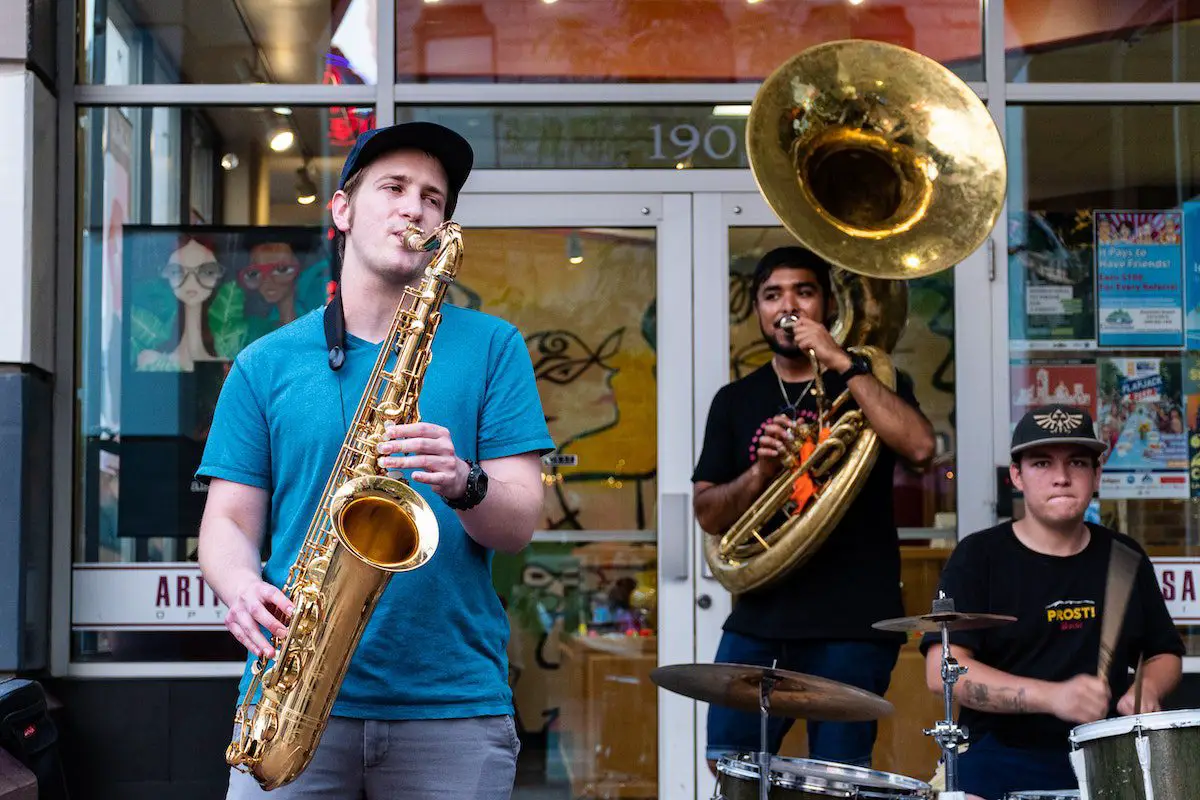Picture this: a musical journey that intertwines harmonies, unleashes rhythms, and sparks endless creativity. Jazz. It’s more than just a genre; it’s a vibrant tapestry that invites you to explore a world of musical possibilities. But what exactly is a jazz band, and how does it come to life? Are you ready to dive into the captivating realm of jazz and discover what makes a jazz band so unique?
What is a jazz band? A jazz band, also known as a jazz ensemble or jazz combo, is a group of musicians who play jazz music together. A traditional jazz band often consists of a rhythm section (including instruments like piano, drums, and bass) and a horn section (including instruments like trumpet, saxophone, and trombone).
What are jazz duos, trios, and quartets?
Jazz duos can feature a variety of instrument combinations, such as piano and saxophone, organ and vocals, or even trumpet and saxophone. These combinations bring together contrasting tones and textures. Take the mesmerizing duo of Makoto Ozone and Gary Burton, who have been enchanting audiences with their piano and vibraphone collaborations for over two decades.

Moving on to jazz trios, this more traditional arrangement typically includes piano or guitar, bass, and drums. The piano or guitar provides harmonic and melodic expression, while the bass and drums establish a solid foundation and rhythmic drive.
This type of ensemble is versatile and can perform a wide range of music, from jazz standards to jazz arrangements of pop or rock tunes. Just check out the Brad Mehldau Trio to experience their phenomenal jazz renditions of popular songs.
Now let’s turn our attention to the classic jazz quartet. Adding a horn to the traditional trio takes the sound to a whole new level. John Coltrane’s classic quartet serves as an excellent example, where the quartet format allowed for melodic harmony and interesting counterpoint elements.
AKAI Professional MPK Mini MK3

AKAI Professional MPK Mini MK3
What are quintets and larger ensembles?
Quintets, as the name suggests, involve adding a fifth member to the classic quartet. For example, if a saxophone player leads the quartet, a trumpet can be added as the second horn. The inclusion of an additional instrument creates a wider range of harmonies, depth, and complexity within the ensemble.
The legendary Miles Davis had a series of groundbreaking quintets throughout the 1950s and 1960s.
The legendary Miles Davis had a series of groundbreaking quintets throughout the 1950s and 1960s. These quintets revolutionized the face of jazz music and launched the careers of renowned musicians like John Coltrane and Wayne Shorter, who went on to lead their own remarkable combos. These quintets pushed the boundaries of improvisation, composition, and collaboration, leaving an indelible mark on the history of jazz.
Beyond quintets, larger groups offer a more expansive canvas for composition, richer harmonies, and an expanded timbre palette. These ensembles can captivate audiences with their intricate arrangements and layered sound. Musicians like Charles Mingus and John Coltrane have composed and performed with larger jazz ensembles, pushing the boundaries of what jazz can achieve.
What instruments make up a jazz band?
A traditional jazz band, also known as a jazz ensemble or jazz combo, usually consists of a rhythm section and a horn section. Here’s a typical setup:
Rhythm Section:
- Piano: The pianist typically supports the group by providing harmonies and can also take on melodic roles for solos.
- Bass: The double bass or electric bass player provides the foundational bassline, working closely with the drummer to establish the rhythm.
- Drums: The drummer maintains the pulse and adds rhythmic accents, contributing significantly to the overall ‘feel’ of the music.
- Guitar: Not present in every group, but when included, the guitarist often shares harmonic and rhythmic duties with the pianist.
Horn Section:
- Trumpet: The trumpet is a common lead instrument in jazz, frequently used for melodic solos.
- Saxophone: The saxophone is another common lead instrument, with different types (alto, tenor, baritone) providing different tonal colors.
- Trombone: The trombone adds depth to the horn section and often provides counter-melodies to the other horns.
While these are the typical instruments, jazz is known for its openness to different instrumental configurations. It’s not unusual to see variations including instruments like the vibraphone, organ, or various types of percussion. Vocalists can also be an integral part of a jazz ensemble.
How do you start a jazz band?
If you’ve been inspired by the world of jazz bands and are eager to start your own ensemble, this section will guide you through the essential steps to get started on your jazz band journey.

- Find like-minded musicians: Seek out fellow musicians who share your passion for jazz. Connect with friends, local music communities, or online platforms to find individuals interested in forming a jazz band.
- Identify compatible instruments: Determine the instrumental combination that aligns with your musical vision. Consider the traditional jazz band instruments like piano, drums, bass, saxophone, or trumpet, or explore non-traditional combinations to create a unique sound.
- Start small: Begin with a smaller configuration, such as a duo or trio, to establish a strong foundation and develop musical chemistry. This allows for focused collaboration and enables each member to shine.
- Explore jazz standards: Dive into the vast repertoire of jazz standards, such as “Autumn Leaves,” “Summertime,” or “All the Things You Are.” These timeless compositions serve as a foundation for jazz musicians, providing a common language and framework for improvisation.
- Arrange popular tunes: Put your own jazz twist on popular songs from other genres. Reimagine familiar melodies in a jazz style, showcasing your band’s creativity and versatility.
- Experiment with original compositions: Foster creativity within your band by composing original jazz tunes. This allows you to explore your unique musical voice and contribute to the ever-evolving jazz landscape.
What are some tips for band growth and progression?
Here are a few tips for growing your own jazz band:
- Rehearse regularly: Dedicate time for regular rehearsals to fine-tune your ensemble’s sound, polish arrangements, and strengthen your musical bond.
- Seek performance opportunities: Look for local venues, community events, or jazz clubs where you can showcase your band’s talent. Live performances not only provide valuable exposure but also offer opportunities for growth and feedback.
- Expand your network: Connect with other jazz musicians, attend jam sessions, and engage in collaborations. Building a network of fellow musicians expands your musical horizons and opens doors to exciting collaborations and learning opportunities.
- Record using a home studio: As you embark on your jazz band journey, having a home recording studio or delving into music production can elevate your musical experience. A home recording studio allows you to capture your band’s sound, experiment with arrangements, and share your music with a wider audience.
Top Ten Popular Jazz Bands
Listed below are some of the most popular jazz bands along with their years active, and their notable songs or albums.
| Band Name | Years Active | Notable Songs/Albums |
|---|---|---|
| Duke Ellington Orchestra | 1923-1974 | “Take the ‘A’ Train,” “Mood Indigo” |
| Count Basie Orchestra | 1935-present | “April in Paris,” “One O’Clock Jump” |
| The Dave Brubeck Quartet | 1951-1967, 1975-1977, 1987-2012 | “Take Five,” “Time Out” |
| The Modern Jazz Quartet | 1952-1974, 1981-1997 | “Django,” “Fontessa” |
| Louis Armstrong and His Hot Five | 1925-1928 | “West End Blues,” “Heebie Jeebies” |
| Miles Davis Quintet | 1955-1968 (Different lineups) | “Kind of Blue,” “Round About Midnight” |
| John Coltrane Quartet | 1960-1965 | “A Love Supreme,” “My Favorite Things” |
| The Ornette Coleman Quartet | 1958-1962 | “The Shape of Jazz to Come,” “Free Jazz” |
| Weather Report | 1970-1986 | “Birdland,” “Heavy Weather” |
| Art Blakey and the Jazz Messengers | 1954-1990 | “Moanin’,” “A Night in Tunisia” |
Whether it’s recording demos, creating polished tracks, or even producing your own jazz album, the possibilities are endless. Embrace technology, explore different recording techniques, and let your jazz band’s unique sound come to life in the comfort of your own home.
If you want even more great tips and information, check out the video.
Frequently asked questions (FAQ)
Here are answers to some common questions that often arise when it comes to understanding jazz bands and their intricacies.
How do jazz bands communicate during improvisation?
During improvisation, jazz bands communicate through a combination of listening, responding, and non-verbal cues. They rely on a shared understanding of the musical language and use eye contact, nods, and gestures to signal transitions, solos, and dynamics.
Can I start a jazz band without extensive knowledge of music theory?
While a solid understanding of music theory can be beneficial, it is not a strict requirement to start a jazz band. Many successful jazz musicians have developed their skills through experience, active listening, and collaboration. The key is to have a passion for the genre and a willingness to learn and grow.
How can I find opportunities to perform with my jazz band?
To find performance opportunities for your jazz band, consider reaching out to local venues, music festivals, community events, or even organizing your own jazz jam sessions. Additionally, networking with other musicians and joining jazz communities can provide valuable connections and open doors to performance opportunities.
Conclusion
Jazz bands, the harmony of instruments, the rhythm of collaboration, and the melody of creativity. Remember, in the world of jazz, there are endless possibilities to explore and create captivating music. So, grab your instrument, gather your bandmates, and let the improvisation begin!
Did I cover everything you wanted to know? Let me know in the comments section below (I read and reply to every comment). If you found this article helpful, share it with a friend, and check out my full blog for more tips and tricks on jazz bands. Thanks for reading and keep on grooving!
Key Takeaways
This article covered the fascinating world of jazz bands and provided insights into their instruments, configurations, and the process of starting and growing a jazz ensemble. Here are some key takeaways:
- Jazz bands can consist of various instruments and configurations, from duos and trios to larger ensembles.
- Each instrument in a jazz band plays a distinct role, contributing to the unique sound and dynamic of the ensemble.
- Starting a jazz band involves finding like-minded musicians, exploring different instrument combinations, and gradually expanding your repertoire and band size.
- Recording jazz bands can be challenging but offers the opportunity to capture the energy, spontaneity, and intricate arrangements of live performances.















